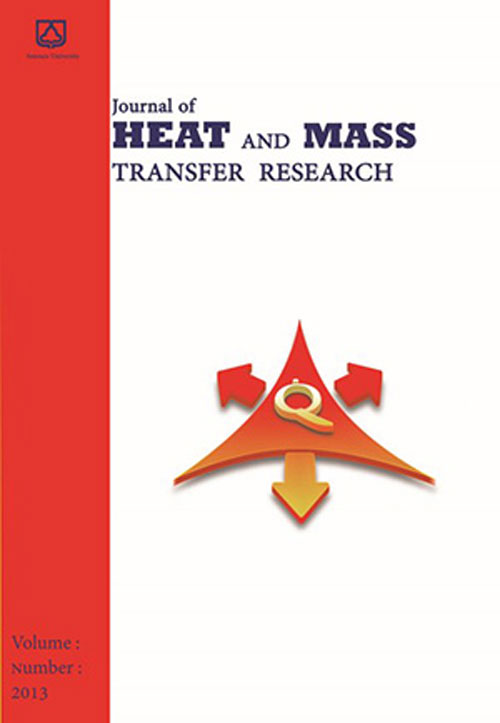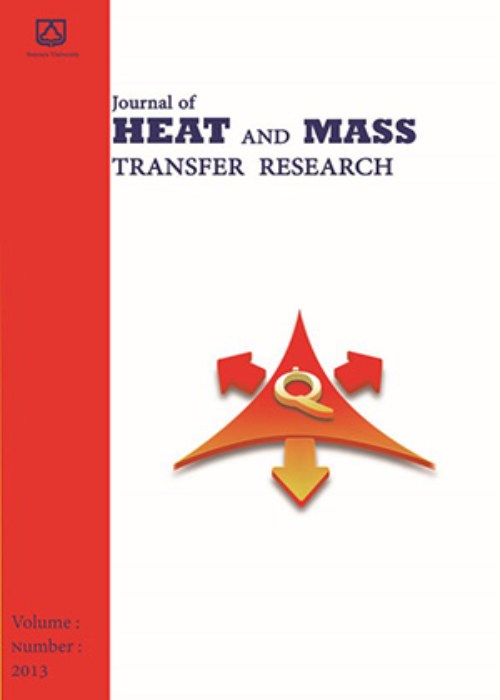فهرست مطالب

Journal of Heat and Mass Transfer Research
Volume:4 Issue: 1, Winter-Spring 2017
- تاریخ انتشار: 1396/10/12
- تعداد عناوین: 7
-
-
Pages 1-11Fe3O4 nanofluid fully developed forced convection inside a copper tube is empirically investigated under the effect of a magnetic field. All of the investigations are performed under laminar flow regime (670≤Re≤1700) and thermal boundary conditions of the tube with uniform thermal flux. The tube is under the effect of a magnetic field in certain points. This research aims to study the effect of various parameters, namely use of nanofluid, nanoparticles volume percent, Reynolds number of the flow, constant magnetic field, and alternating magnetic field with various frequencies on flow behavior. To validate the experiment set-up, distilled water is utilized as working fluid. The results are compared with Shahs equation and acceptable agreements are achieved. The results suggest that owing to complex convectional flows developed in the fluid as a result of Fe3O4 nanoparticles-magnetic field interaction, increased alternating frequency of the magnetic field and increased volume fraction lead to increase heat transfer to maximum value 4.62. As Reynolds number increases, the rate of the said increase is reduced and reached to 0.29. At a constant Reynolds number, increased frequency of the alternating magnetic field results in an increased local heat transfer coefficient. However, this increase is unproportional to increase in frequency. In high frequencies, increased frequency leads to a slight increase in the heat transfer coefficient.Keywords: Ferrofluid, Nanoparticles, Convection, alternating magnetic field, experimental study
-
Pages 13-20The aim of the present study was to propose a panel being sensitive to the direction of heat transfer. For this purpose, a vertical rectangular cavity with prescribed dimensions was prepared and filled with water as the working fluid. A vertical mid-plane solid partition was installed within the cavity. Two relatively wide openings were created at the top and bottom of the partition and they were so equipped to operate as a pair of one-way flow controllers. The cavity was then fixed between two thick aluminum blocks by which, the contact surfaces of the cavity were maintained at almost constant but different temperatures. Heat transfer rate through the cavity was evaluated for the same temperature difference applied in the two opposed directions. Based on the results, heat transfer rate in one direction was about 30% higher than that of the reverse direction. The difference in the heat transfer rate was obviously due to the individual flow patterns developed within the modified cavity. As a result, the proposed cavity is capable of restricting heat transfer rate in one direction compared to the other, when applying the same temperature difference across the cavity.Keywords: Free convection, direction-sensitive heat transfer, vertical cavity
-
Pages 21-34The conversion and utilization of biomass as an alternative source of energy have been subjects of interest in various countries, but technical barriers to the technology and design of conversion plants have considerably impeded the development and use of alternative power sources. Theoretical studies on the conversion process enhance our understanding of the thermochemical conversion of solid fuels. Carrying out such research necessitates the development of thermal and kinetic models of pyrolysis, on which the conversion process integrally depends. Another requirement is to analytically solve the aforementioned models to derive valuable insight into the actual process of biomass conversion. Accordingly, this study used Laplace and Hankel transforms to obtain analytical solutions to heat transfer models of rectangular, cylindrical, and spherical biomass particles. Pyrolysis kinetic models were also analytically solved using the Laplace transform. The study then investigated the effects of particle shape, particle size, isothermal and non-isothermal heating conditions, and convective and radiative heat transfer (calculated using a modified Biot number) on the pyrolysis of a biomass particle. This work is expected to substantially contribute to the design of pyrolysis reactors/units and the optimal design of biomass gasifiers.Keywords: Energy, Biomass particles, Pyrolysis, Heat transfer, Integral transform method, Analytical solutions
-
Pages 35-43To increase the numerical accuracy in solving engineering problems, either conventional methods on a fine grid or methods with a high order of accuracy on a coarse grid can be used. In the present research, the second approach is utilized and the arbitrary high order Discontinues Galerkin Arbitrary DERivative (DG-ADER) method is applied to analyze the transient isothermal flow of natural gas through pipelines. The problem is investigated one dimensionally and the effect of friction force between the pipe wall and fluid flow is considered as a source term on the right-hand side of the momentum equation. Therefore, the governing equations have a hyperbolic nature. Two real problems with available field data are simulated using this method. The results show that using DG-ADER method, high accurate results can be obtained even on a coarse grid. Furthermore, the conventional small-amplitude oscillations of DG-ADER scheme do not appear in the transient natural gas flow problems, due to the smoothness of flow field properties.Keywords: transient natural gas flow, Numerical Simulation, high order DG-ADER scheme, isothermal flow
-
Pages 45-52In this study, the numerical analysis of turbulent flow and heat transfer of double pulsating impinging jets on a flat surface has been investigated. The unsteady two-dimensional numerical solution for two similar and dissimilar jets was performed using the RNG k-ε model. The results showed that the RNG k-ε model has more satisfactory predictions of the Nusselt number distribution. Comparisons show that for two identical jets with constant frequency and amplitude, increasing Reynolds number leads to the considerable increase of time-averaged Nusselt number. Also, with increasing oscillation amplitude, the averaged Nusselt number of surface increased. The results show that increasing the phase difference angle of pulsating jets leads to the increase of mixing between jets, which consequences the increase of Nusselt number in this zone. It should be mentioned that for two jets by equal frequency and phase angle, increasing oscillating amplitude of one jet leads to an asymmetric distribution of the Nusselt number. In this case, the averaged Nusselt number between two jets increased. Furthermore, the array of double jets with different oscillating type (intermittent and sinusoidal) leads to the increase of averaged Nusselt number considerably in the stagnation region between the jets.Keywords: Turbulent flow, Impingement Heat Transfer, Pulsating jet, Average Nusselt Number
-
Pages 53-64The heat transfer for a non-Newtonian power-law fluid over a moving surface is investigated by applying a uniform suction/injection velocity profile. The flow is influenced by internal heat generation/absorption. The energy equation is solved at constant surface temperature condition. The Merk-Chao series is applied to obtain a set of ODEs instead of a complicated PDE. The converted ordinary differential equations are solved numerically, adopting the fourth order RungeKutta method coupled with the shooting technique. The effects of the fluid type, suction/injection and heat source/sink parameters on heat-transfer are discussed. It is observed that thermal boundary layers for pseudo plastic fluids are thicker than that of the dilatants. There exists a direct relation between dimensionless temperature and the injection parameter or the heat generation parameter rise. Injection of a fluid to the surface generates more flow penetration into the fluid, which causes an increase in the thermal boundary layer and the temperature.Keywords: Heat transfer, Moving wall, Merck-Chao, Power-law
-
Pages 65-72A heat exchanger using nanofluid needs to operate at optimum mass concentration level to get the maximum heat transfer performance. A numerical analysis is performed on the heat transfer and pressure drop of water-based γ-Al2O3 nanofluid gasketed-plate heat exchanger to specify its optimum conditions. Cold water will be heated by γ-Al2O3/water nanofluid. The results showed that optimal volume concentration of γ-Al2O3/water nanofluid based on a maximum performance index is about 0.016. The heat transfer rate at the optimal concentration of nanofluid is approximately 12.3% higher than that of pure water (base fluid), while pumping power is increased by 1.15%. With regard to 1% enhancement in heat transfer rate with increasing ϕ values from ϕ=0.016 to ϕ=0.028 (optimum volume concentration for maximum heat transfer rate) and the pumping power required for nanofluid, the optimum concentration for maximum performance index is selected as the best level of particle volume fraction for γ-Al2O3/water nanofluid in this research.Keywords: Nanofluid, Particle volume fraction, Gasketed-plate heat exchanger, Heat transfer, pressure drop


